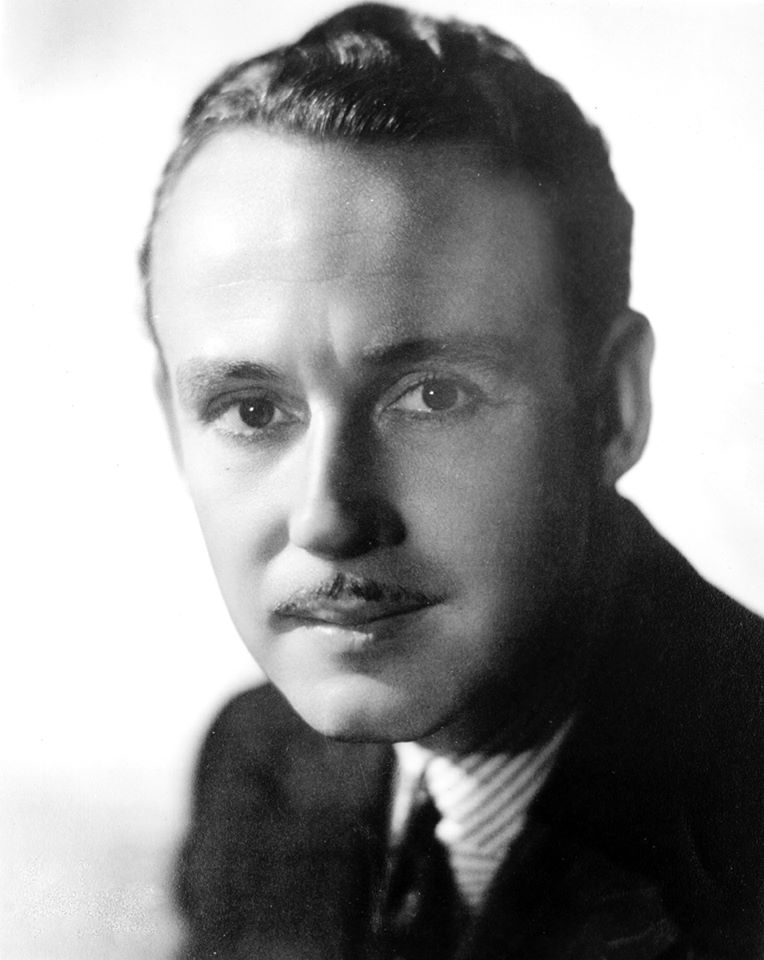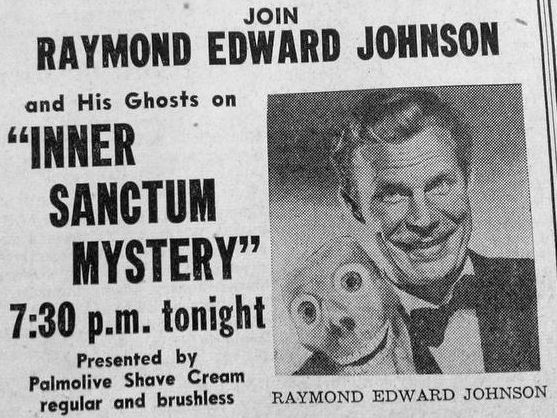“Welcome to the mysterious circle of the Inner Sanctum…”
Posted by Ivan G. Shreve, Jr. on Jan 7th 2018
Established in 1924 by Richard L. Simon (father of singer-songwriter Carly Simon) and M. Lincoln “Max” Schuster as a vehicle to sell crossword puzzle books, the company known as Simon & Schuster (still in existence today, by the way) quickly established itself as a leader in the publishing field with innovations in mass-marketing and distribution. Additionally, they were the first to offer booksellers the option of returning unsold books for credit, and Simon & Schuster can also lay claim to creating the modern paperback when they instituted their “Pocket Books” line in 1939. With the introduction of a series of novels in 1930 that the company dubbed “Inner Sanctum” (color-coded books in which the subject matter ranged from serious drama to detective/mystery stories), Simon & Schuster can accept responsibility for one of old-time radio’s classic horror anthologies…which made its radio debut on this date in 1941.
It was, in fact, a radio show that inspired the “Inner Sanctum” book series…that would return full circle to radio. Simon & Schuster’s rival Street and Smith had agreed to sponsor CBS’ The Detective Story Hour in 1930 to boost sales of their publication Detective Story Magazine. (That program would later metamorphose into The Shadow.) The “Inner Sanctum” book series was introduced in that same year, but it received a rather lukewarm reception from the book-buying public. Had it not been for the company’s decision to reissue the first novel in that series—Claude Haughton’s I Am Jonathan Scrivener—in 1935, the book franchise might never have given birth to its eventual radio counterpart. But the “Inner Sanctum” series began to move product, and with the success of other radio horror programs, such as The Witch’s Tale and Lights Out, it would only be a matter of time before radio listeners began turning down their lights for additional goosebumps.
The task of bringing Inner Sanctum Mysteries before the microphones would fall to radio veteran Himan Brown. The director-producer of any number of shows from soap operas (Marie, the Little French Princess, Joyce Jordan, M.D.) to juvenile action (Dick Tracy, Flash Gordon), by the 1940s Brown had become a one-man industry when it came to initiating radio programs, enjoying success with hits like Bulldog Drummond and The Adventures of the Thin Man. Hi had approached Simon & Schuster with the proposition for a radio version of Sanctum, but rather than sponsoring the show by their lonesome they suggested he line up someone else to pay the bills. Faster than you can say “Your host, Raymond” Brown had persuaded Carter’s Little Liver Pills to sign on the dotted line…and Inner Sanctum Mysteries made its debut over the Blue Network on January 7, 1941.
 “Your host,
Raymond” was actor Raymond Edward Johnson, who Himan Brown hired to introduce
each week’s bloodcurdling tale of murder and mayhem. Raymond would
eventually morph into what some might recognize as an embryonic version of the
modern-day television horror movie host, cracking atrocious puns in a jovial,
tongue-in-cheek manner. (“Well, it’s so nice of you to come
here tonight…and…uh…help me sit up with a corpse…he’s
such dull company…so cold and stiff…”) Raymond
would make his entrance after the program’s signature opening: three bars of
organ music punctuated by a sting…and then the sound of a doorknob turning.
Listeners then heard a door swinging in slowly with an ominous creak…
“Your host,
Raymond” was actor Raymond Edward Johnson, who Himan Brown hired to introduce
each week’s bloodcurdling tale of murder and mayhem. Raymond would
eventually morph into what some might recognize as an embryonic version of the
modern-day television horror movie host, cracking atrocious puns in a jovial,
tongue-in-cheek manner. (“Well, it’s so nice of you to come
here tonight…and…uh…help me sit up with a corpse…he’s
such dull company…so cold and stiff…”) Raymond
would make his entrance after the program’s signature opening: three bars of
organ music punctuated by a sting…and then the sound of a doorknob turning.
Listeners then heard a door swinging in slowly with an ominous creak…
The idea for the “creaking door” sprang from a sound effect that Himan Brown had previously used on a broadcast of Dick Tracy, though in later years Brown would reminisce that the inspiration had been the basement door in a studio where he had once worked. As he relayed it in Martin Grams, Jr.’s Inner Sanctum Mysteries: Behind the Creaking Door, “The door told me to use it. The door spoke to me. ‘Make me a star,’ it said.” Brown was true to his word; the rusty hinges of the door to the Inner Sanctum would become one of radio’s beloved sound effects, and one of only two sounds from Radio’s Golden Age to be copyrighted (the other being the NBC chimes).
The content of Inner Sanctum Mysteries fluctuated between classic horror tales (like Edgar Allan Poe’s “The Fall of the House of Usher” and “The Tell-Tale Heart”) and original stories of terror with a dash of the supernatural for spice. Modern-day listeners have occasionally described surviving recordings as “camp”; Sanctum never made any bones (see what I did there?) about subtlety, and many of its dramas would call it a wrap with endings not too far removed from an episode of Scooby Doo, Where are You? (“It’s Old Mr. Crabtree, the owner of the amusement park!”) In its purest form, Inner Sanctum offered simple, old-fashioned entertainment—the sort of spinetingling spook tales one might tell around a campfire. Sanctum also boasted a most impressive list of Hollywood celebrities that guest starred now and then, with performances from horror icons Boris Karloff and Peter Lorre supplemented by the likes of non-horror actors such as Mary Astor and Raymond Massey. For the most part, the series chiefly drew upon a rich pool of New York radio talent with veterans like Berry Kroeger, Lesley Woods, Santos Ortega, and Everett Sloane.

When Inner Sanctum Mysteries moved to CBS in the fall of 1943, the sponsorship shifted to Colgate-Palmolive-Peet. In January of 1945, the series took on its best-remembered sponsor in Lipton’s Tea, with host Raymond regularly matching wits with Lipton spokeswoman Mary Bennett. (Mary would scold Raymond when he insisted on adding his macabre sense of humor to the commercials.) Sanctum’s longest-running sponsor was the Emerson Drug Company (from 1946-50 and distinguished by another memorable ad for “bromoseltzer…bromoseltzer…bromoseltzer“), but by that time Raymond Edward Johnson’s hosting duties had shifted to actor-announcer Paul McGrath. (Johnson had left the show in May of 1945 after receiving greetings from Uncle Sam.) McGrath sounded similar to the departing Johnson but decided to keep his identity a secret by referring to himself simply as “your host.”
In July of 1950, Inner Sanctum Mysteries returned to its old Blue neighborhood (now known as ABC) as a summer sustainer, and then persuaded Mars Candy to pick up the check in September, continuing in that capacity until June 18, 1951. The radio show had one more brief summer run on CBS in 1952 (sponsored by the Pearson Pharmaceutical Company) before giving up the ghost (okay, I promise to stop now). An attempt was made to bring Inner Sanctum to the small screen in the form of a syndicated TV series (produced in 1953 and telecast in 1954), but it failed to catch fire…much in the same manner as a short-lived Universal movie franchise (six films produced between 1943 and 1945). Inner Sanctum remains a show that works best for those who truly enjoy “the theater of the mind.” (When I was in fifth grade, my English teacher had me spellbound with reminisces of listening to the show when she was a youngster.)

To celebrate the anniversary of Inner Sanctum Mysteries, Radio Spirits invites you to sample some of its eerie delights with three deliciously terrifying tales in our potpourri release of Great Radio Horror. After you’ve finished with that appetizer, you’re ready for the main course in Shadows of Death—an eight-CD set with sixteen vintage broadcasts (and liner notes by yours truly). It wouldn’t be a complete meal without dessert, of course, so we offer up our newest Sanctum collection, Pattern for Fear, with sixteen additional episodes of “the fear you can hear.” As for me…well, it’s time to close that squeaking door…good niiii-iight…pleasant dreeeeeaaaaammmmmsssss…

